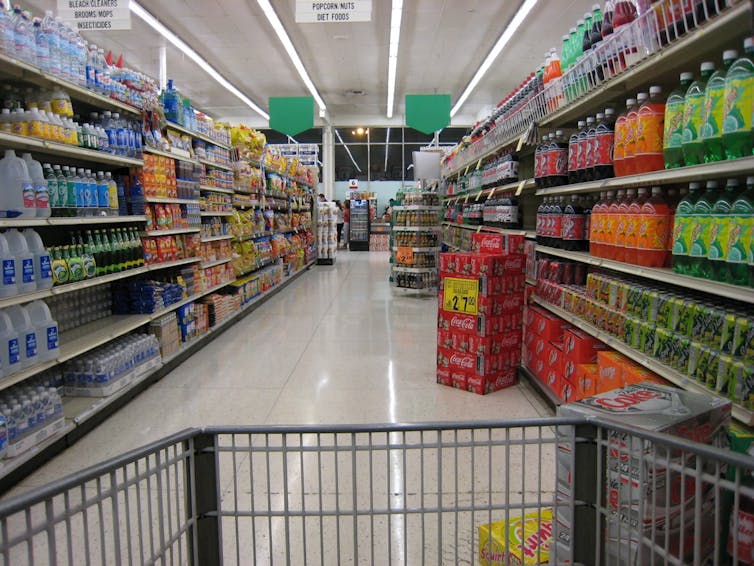The cost of living crisis is dominating headlines at the moment. With so much conflicting information flying around, it can be hard to work out what is the best way to look after your household finances.
Banks, energy providers and shops will often try to blind you with big numbers and confusing mathematical terms – often preying on people’s fear of mathematics. However, even if you count yourself as a numberphobe, there are a few very simple steps you can take to use maths in your favour and save some money.
The trouble with averages
For most people, the biggest impact on the cost of living will come from hikes in gas and electricity costs. This is tied to the price cap, which is set by Ofgem. But much of the reporting around this cap is somewhat misleading.
Last week, the October price cap was announced as being £3,549. But that price is based on an average household. The very nature of an average is that roughly half of households will use more energy than this, and roughly half will use less.
Therefore, it is very useful to have an idea of how much energy your own household actually uses in a year. If you have lived in the same house for a few years, you can look at your usage over previous years as a guide. If you’re in a new home, you can make an estimate by factoring in the size of house, number of people who live there and other information using an energy consumption calculator.
Your energy bill for each type of fuel is based on two values – a daily standing charge (SC), which you pay every day regardless of usage, and a cost per unit of energy (CPU). Once you know how many units (u) of that fuel you use per year, you can easily calculate your expected bill for a given year by computing (365 x SC) + (u x CPU).
Know your percentages
Another huge contributor to the cost of living crisis is the rocketing inflation rate, which currently sits at 8.8%. In response to this, the Bank of England has raised its base rate to 1.75%, which has a knock-on effect on interest rates on both savings and loans.
The impact of this change in the short term depends on whether you are in net debt. If you have more money in savings than in loans (including your mortgage, student loans etc), then it’s possible the increased interest rate will give you an opportunity to address some of the impacts of inflation. However, if the opposite is true, and especially if you are coming to the end of the fixed-rate period of a mortgage, then you will most likely be a lot worse off than you are now.
The simplest way to review the impact is to look at the interest rates associated with each of your accounts. For a savings account, a 2% interest rate on a balance of £100 will leave you with £102 at the end of the year. If it’s a loan, you’ll owe £2 more. If you have both but the savings account has a lower interest rate, then it may be in your interest to use at least some of those savings to pay off your loan.
However, most loans – including most mortgages – are repayment loans, which means you borrow a certain amount and then pay it off over a pre-agreed period, according to a certain formula. The way such loans are structured means the first few payments will see the majority of your money going towards the interest, with the overall balance being reduced by only a small amount. For a £150,000 loan at a 4% interest rate over 25 years, your monthly payment would be £791.76 – and in the first month, £500 of that would be interest.
Therefore in many cases, if you are in the early stages of a mortgage and have the ability to overpay, you may save yourself a lot more money in the long run. You can use mortgage calculators to look at how much of your monthly payment actually goes towards paying off your debt.
Divide and conquer
The aisles of large supermarkets can be confusing places, with different versions and sizes of the same product available at a wide range of prices designed to bamboozle you. For example, the soft drinks aisle of my local shop often includes 2-litre, 1.5-litre, 1.25-litre, 1-litre, 600ml and 500ml bottles, plus 330ml and 150ml cans sold individually and in multi-packs.

Simon Shek/Flickr, CC BY-SA
Although it’s typically true that the larger sizes are better value (and better for the environment since they use less packaging), this isn’t always the case once you factor in special offers. A simple tip that will work for any non-perishable product is to calculate the price per unit so you have a direct comparison.
For example, if a 2-litre (2000ml) bottle of cola costs £1.75, that means the cost per 100ml is 175/20 = 8.75p. The equivalent for a 1.25-litre bottle on offer at £1 would be 100/12.5 = 8p per litre, meaning the smaller bottle would be better value in this case.
In many cases, supermarkets include these costs on the price label to help you out. Even when they don’t, it might be worth calculating the unit costs of more expensive products to save yourself a few quid each week.
Don’t expect the unexpected
It can be tempting to think about the potential riches of winning big in a lottery or hitting the casino, but these are surefire ways to lose money on average. That’s because of the statistical concept of expected value – the average outcome you would expect if you could theoretically repeat an activity over and over again.
Suppose I suggested a game where we rolled a die, and if it was a number from one to five you had to give me £1, but if it was a six you’d get £2. Clearly that wouldn’t seem like a good idea since I would win most of the time, so your “prize” for getting lucky isn’t high enough. But how do we know what prize would be high enough? That’s where our expected value comes in.
Think about the first example. All six outcomes from throwing a die are equally likely. In one of the six outcomes your profit is £2, but in five of the six outcomes you lose £1 (i.e. have a profit of -£1). We can use some simple probability to calculate your expected profit from this game:
E(profit) = (-£1 * 5/6) + (£2 * 1/6) = -£1/2 (or -50p).
On average, every time we play, you will lose 50p. But using the same equation, if the “prize” for rolling a 6 is increased to £5, then E(profit) = 0. On average, you will now break even from this game. A prize of £8 gives E(profit) = 50p, meaning that on average you would win 50p each time you played.
We can apply a similar concept to the National Lottery, where the odds of matching six numbers can be calculated using some slightly more complicated probability. Based on this, the expected value of a £2 lottery ticket on August 27 was 95p – if this draw was repeated over and over again, you’d lose over £1 each time. Therefore, the lottery should not be considered anything more than a bit of fun, except perhaps on the rare exceptions where there is a large rollover prize.
Similar concepts apply to a casino, where the house introduces measures specifically designed to weight the odds in its favour. For example, the presence of the 0 on a roulette wheel means the expected value from a £1 bet on a particular number is 97.3p – in other words, you lose over 2p per spin on average.
Ultimately, it is going to be a very challenging winter for most of us. The main way the country can overcome this crisis is with more large-scale help. But while we wait to see if that actually arrives, all we can really do as individuals is make small changes, and of course help out others less fortunate than ourselves.
![]()
Craig Anderson does not work for, consult, own shares in or receive funding from any company or organisation that would benefit from this article, and has disclosed no relevant affiliations beyond their academic appointment.











